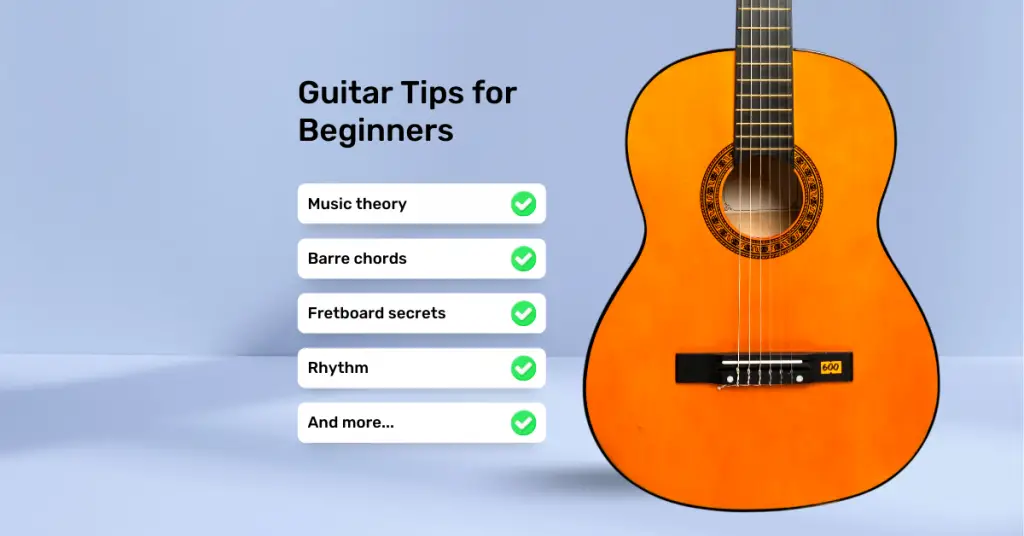Table of Contents
When you’re just getting started on guitar it’s good to develop some habitual exercises.
These easy guitar exercises for beginners will help you progress quickly if you practice them daily.
Check ’em out.
Exercise 1: Warm-up Stretches
Stretching your hands before playing will keep your hands healthy and in good shape.
Doing warm-up exercises will help with circulation in the left and right hands, and will allow you to use wider stretches on the guitar.
While I am not an expert on physical therapy, the best exercise that has worked for me is stretching all five of my fingers backwards, and holding them there for no longer than 10 seconds.
Carl Brown demonstrates this exercise very well at 3:18
This article from Seymour Duncan is also very helpful, and dives deeper into hand stretching, and how to practice stretching safely.
Keep it Loose: Stretches for Guitarists
Exercise 2: Find The Notes
Learning the notes on the guitar is essential.
This is the alphabet for your instrument, and memorizing this alphabet will help you communicate with other musicians, learn songs faster, and have a better overall understanding of the guitar.
One of the easiest ways to start memorizing the notes is to actively seek them out.
The good news is you only need to actively learn the 7 natural notes: A, B, C, D, E, F, and G. You can easily find accidentals (sharps and flats) once you know the natural note names.
Use this awesome chart to help:
You can take advantage of this chart on: https://www.fatpick.com/tools/fretboard-generator
Note Finding Process
Use the fretboard chart that only shows the natural notes, and pick a note on the Low E string or A string.
Once you’ve chosen a note, you’ll want to play it anywhere on the fretboard behind or at the 12th fret.
If you memorize the natural notes on all frets at and behind the 12th fret, then you’ll be able to find the note names in front of the 12th fret by looking at them as octaves.
For example, if we know that the 3rd fret of low/high E is a G note, we can move that note up 12 frets (an octave), which gets us to the 15th fret, which is our G note an octave higher.
Anyways, start with a commonly used note, like E. Play the 12th fret E, then play that same note again at the 7th fret A, and play it again at the 2nd fret D. Say the note out loud as you play them.
Once again, repeat this process for every note.
Doing this for five minutes a day, using a different natural note for each of the 7 days in a week, you’ll have the natural notes memorized in no time.
Exercise 3: 4-Step Fretting Exercise
The 4-step fretting exercise helps you to remember and practice chord shapes. I learned this exercise from an older guitar book.
The process is simple:
- Set
- Press
- Set
- Release
Try practicing this exercise with an open C chord.
1: start by setting your chord shape on the strings lightly.
2: press all of your fingers simultaneously and strum your chord.
3: put your fingers back in the set position, roughly 1/8th of an inch away from the fretboard.
4: release your fingers.
This exercise allows you to practice your guitar chord shapes without stressing out the fretting hand, and helps your fretting hand to memorize these shapes.
You can find a video addressing this exercise in module 3B of my guitar course. Using that link you can get 1 month free on Skillshare, which you can use to watch the course!
You can also learn more about beginner guitar chord shapes with this article:
Exercise 4: Alternate Picking Spider Exercise
The spider exercise is a fretting hand exercise that uses all 4 fingers.
I suggest that you practice the exercise with alternate picking, but you can also practice the exercise with hammer-ons/pull-offs.
Here’s the most popular spider exercise:
The spider exercise is a spectacular exercise for beginners because of it’s use of all 4 fingers on the fretting hand, and the use of alternate picking with the right hand.
However, once you’ve played this beginner exercise enough, you’ll need to take it to the next level.
Here’s a YouTube video from Uncle Ben Eller that shows you how to do that!
Exercise 5: A Minor Pentatonic
The minor pentatonic scale is one of the most commonly used scales on the guitar.
It’s a simple 5 note scale, and it has five positions. You’ll practice it in the key of A minor, because A minor pentatonic one of the most common minor pentatonic scales.
Practice all five of these positions using alternate picking. Practice ascending (Low E- High E) and descending (High E back to Low E) the scale.
Take note of how the last note played on each string in any position will act as the starting note for each string in the next position.
Summary: Easy Guitar Exercises for Beginners
These easy guitar exercises for beginners will exercise 5 essential practice elements for guitar.
Your warm-ups will keep your hands healthy.
Memorizing your notes will be your primary first step into guitar theory.
The 4-step fretting exercise will help you learn chords from here on out.
The spider exercise will exercise all 4 fingers on the fretting hand, and turn you into an alternate picking machine.
And lastly, your minor pentatonic scale will lead you in the right direction for learning lead guitar and memorizing scales.



